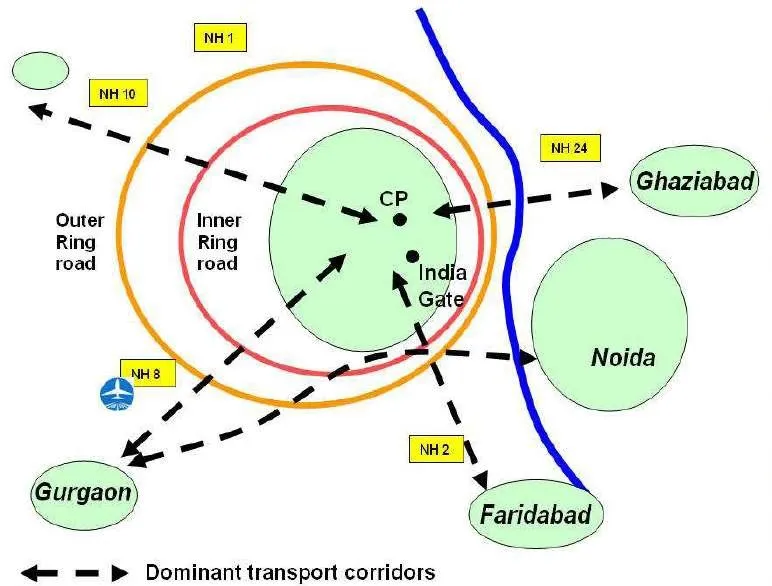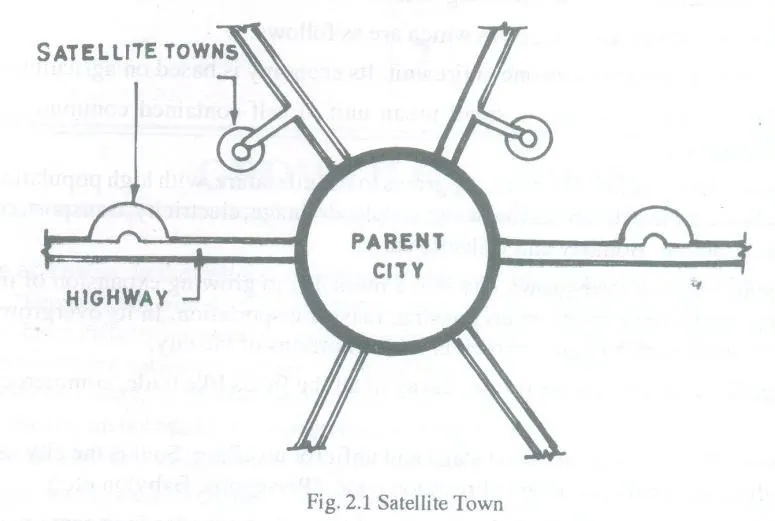If you want to know about the radburn theory or ekistics development theory or residential space planning, please click the link.
The concept of satellite town planning refers to the development of small, self-contained towns around a larger city. These towns are designed to provide housing and employment opportunities for people who work in the city, but want to live in a more suburban or rural environment.

The aim of satellite town planning is to reduce urban sprawl and congestion, improve access to services and amenities, and promote sustainable and equitable urban development.
The satellite town concept is typically characterized by a mix of residential, commercial, and industrial land uses, as well as well-designed public spaces, transportation networks, and infrastructure.
1) Satellite town (Introduction)
A satellite town is a small, self-contained town or urban area that is located near a larger city.
It is designed to provide housing and employment opportunities for people who work in the city but want to live in a more suburban or rural environment.
The idea behind satellite towns is to reduce urban sprawl and congestion, and promote sustainable and equitable urban development.
A satellite town or satellite city is a concept in urban planning that refers essentially to miniature metropolitan areas on the fringe of larger ones.

- The satellite growth implies dependency on the parent city but still possessing its own identity. When town reaches a certain size, satellite devolution must take place, to break the suburban sprawl beyond that size.
- Since its periphery falls away from the heart of the parent city, it becomes less convenient and uncomfortable for the distant people. e.g: Faridabad near Delhi, Marimalai near Madras, Sikandarabad near Hyderabad
The satellite town will have the following features
- A satellite town is also a full town in true sense but depends to certain extent on the parent city for higher Education, Employment.
- It is however independent in its economic, social and cultural activities.
- It is a pure residential units with civic amenities like small shopping centers, dispensary, primary and nursery schools etc.
- Here no industries are permitted, hence the people will have to depend on parent city for any workshop and employment facilities.
- It must be linked with parent city by easy transport facilities like buses, local trains. There will be only one arterial road for communication.
- It may or may not consist of zoning.
- Every house may or may not having Gardens.
- It is generally situated in an open country beyond the green belt of the parent city
- Its size and development should be controlled and not allowed to grow more than its parent city. Otherwise it would grow to become a rival to the parent city and would create the same problems of control in future.
Here’s some additional information
- The concept of satellite towns originated in the United Kingdom in the 1940s and 1950s, and has since been adopted and adapted in many other countries.
- Satellite towns are usually planned and developed by government agencies, private developers, or a combination of both. They typically involve the construction of new communities, or the expansion and upgrading of existing towns and villages.
- The goal of satellite town planning is to create a balanced, sustainable, and livable urban environment that meets the needs of residents, workers, and businesses. This includes providing access to quality housing, education, health care, recreation, and other essential services.
- Satellite towns are also designed to reduce traffic congestion, air pollution, and energy consumption by encouraging people to live closer to where they work, and by providing efficient public transportation and non-motorized transportation options.
- Some of the key challenges in implementing the satellite town concept include acquiring suitable land, securing financing, coordinating with neighboring municipalities and regional authorities, and ensuring social and economic integration between the satellite town and the surrounding area.
- Despite these challenges, satellite town planning continues to be an important strategy for promoting sustainable urban development, and has been successful in many countries around the world.
Growth of towns by flow type

2) Advantages of satellite town planning
Here are some of the advantages of satellite town planning:
- Reduced Urban Sprawl: By providing alternative housing options near a larger city, satellite towns can help reduce urban sprawl and keep growth more compact and sustainable.
- Improved Access to Services and Amenities: Satellite towns are designed to provide residents with access to quality housing, education, health care, recreation, and other essential services, which can improve quality of life and reduce the need to travel to the city for these services.
- Reduced Congestion and Pollution: Satellite towns are often designed to reduce traffic congestion and air pollution, by encouraging people to live closer to where they work and by providing efficient public transportation and non-motorized transportation options.
- Economic Development: Satellite towns can provide new employment opportunities, stimulate local economic growth, and create new markets for goods and services.
- Better Quality of Life: With well-designed public spaces, community centers, and recreational facilities, satellite towns can foster a sense of community and improve quality of life for residents.
- Increased Housing Diversity: By providing a range of housing options, satellite towns can help to meet the diverse needs and preferences of different income groups and demographic groups.
- More Sustainable Development: With a focus on sustainability, including green spaces, energy-efficient buildings, and environmentally friendly transportation options, satellite towns can promote responsible and sustainable urban development.
These are some of the main advantages of satellite town planning, but the specific benefits will depend on the location, development goals, and local conditions.
3) Disadvantages of satellite town planning

Here are some of the disadvantages of satellite town planning:
- High Development Costs: Developing new towns or upgrading existing ones can be expensive, and securing financing can be a challenge, particularly in developing countries.
- Land Acquisition Issues: Finding suitable land for satellite towns can be difficult, particularly in areas with high land values or strong opposition from local residents or environmental groups.
- Integration with Surrounding Areas: Ensuring social and economic integration between the satellite town and the surrounding area can be challenging, particularly if there are differences in wealth, ethnicity, or culture.
- Lack of Jobs: Some satellite towns may struggle to attract and retain businesses, which can limit employment opportunities for residents and result in high levels of commuting to the city.
- Transportation Challenges: Reliance on public transportation can be problematic, particularly if it is slow, unreliable, or expensive, and this can discourage people from living in satellite towns.
- Lack of Urban Character: Some satellite towns may lack the cultural, historical, and architectural character that is found in established cities, which can reduce their appeal for some residents.
- Dependence on Cars: Despite efforts to promote alternative modes of transportation, many satellite towns still rely heavily on cars, which can result in increased traffic congestion and air pollution.
These are some of the potential disadvantages of satellite town planning, but the specific challenges will depend on the location, development goals, and local conditions.
4) Satellite towns … Characteristics
Satellite cities are small or medium-sized cities near a large metropolis. Satellite cities are at least partially independent from that metropolis economically and socially. Satellite cities are physically separated from the metropolis by rural territory; satellite cities should have their own independent urbanized area, or equivalent; Have their own bedroom communities.
Satellite townships have their own local government and corporate life. They have all the necessary amenities and facilities present within their limits except for a few purposes like employment and sometimes education, they have to depend on the main city, i.e., the parent city.
Satellite townships generally develop beyond the green belt of the city. These townships never become a rival to their parent city because their size and development is restricted and controlled.

Here are some of the common characteristics of satellite towns:
- Location: Satellite towns are usually located within commuting distance of a larger city, and are often connected to it by public transportation or major highways.
- Land Use: Satellite towns typically feature a mix of residential, commercial, and industrial land uses, as well as public spaces such as parks, open spaces, and community facilities.
- Housing: Satellite towns are designed to provide a range of housing options, from single-family homes to multi-family apartments and condominiums, to meet the needs of different income groups and demographic groups.
- Transportation: Satellite towns are usually designed to have a well-connected transportation network, including public transportation, bike paths, and pedestrian walkways, to reduce dependence on cars and encourage alternative modes of transportation.
- Infrastructure: Satellite towns typically have modern infrastructure and public services, including water and sewer systems, electricity and telecommunications, schools, health care facilities, and emergency services.
- Sustainability: Many satellite towns are designed with sustainability in mind, and feature green spaces, energy-efficient buildings, and environmentally friendly transportation options.
- Community: Satellite towns are often designed to promote community and social interaction, with well-designed public spaces, community centers, and recreational facilities.
These are some of the key characteristics of satellite towns, but the specific features of each town will depend on local conditions, development goals, and community needs.
EXCELLENT……….. I have no words…….. MASTERPIECE